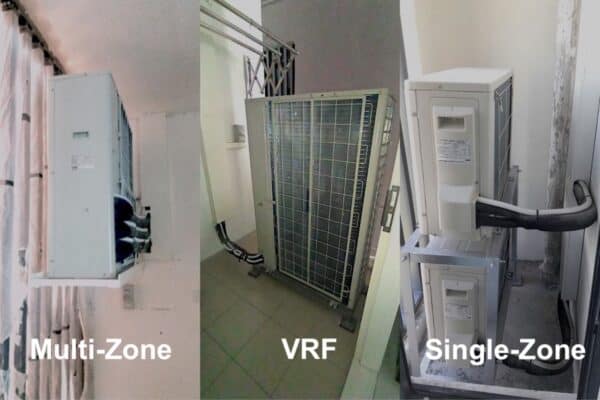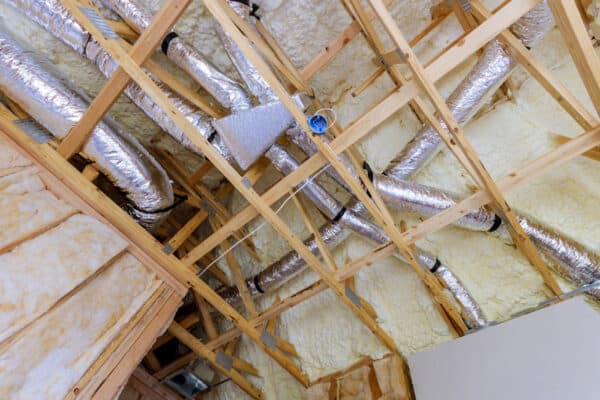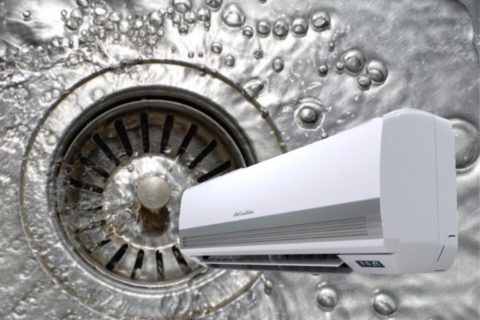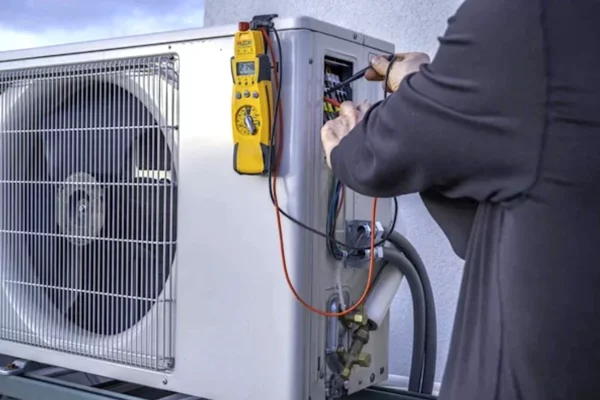What is a Mini-Split? | A Complete Guide
Mini-splits are getting popular nowadays. They are said to be more efficient and save electricity costs. Mini-splits may be new to some people and hence, they are not familiar with mini-splits. So, what is a mini-split?
A mini-split is a decentralized heating and cooling system that enables houses to have independent room temperature controls. Since the capacity of a single mini-split unit is relatively lower, a single-family house usually needs about 4-6 mini-splits for adequate heating and cooling. However, mini-splits often save more electricity costs than other heating and cooling systems.
Houses in countries like the United States are often built with a centralized split air conditioner or a gas furnace combo that uses ductwork for air distribution.
On the other hand, most mini-splits are ductless. Thus, they are simpler yet more efficient. However, most people had never dealt with installing a new HVAC unit, let alone the relatively new mini-split system.
So, if you’re thinking of installing a mini-split in one of your rooms (eg: garage, sunroom and newly built bedroom) or the entire house, this post will outline everything that is necessary for you to make an informed decision.
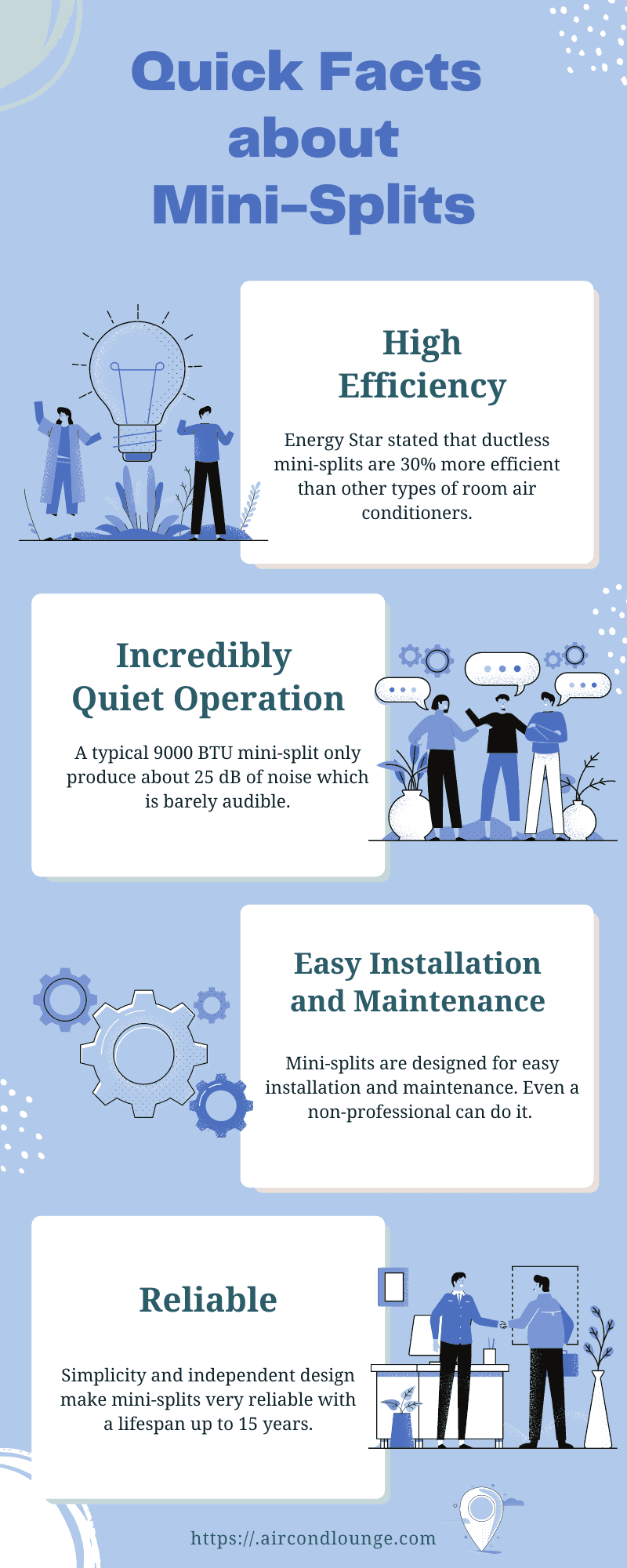
Table of Content
Following is the content of this post. Click the link to skip to the content within this post. However, this post is meant to be read from the start to the end. Skipping may cause you to miss out on some of the items.
- Mini-Split vs Central Air/Gas Furnace
- Mini-Split Overview
- When Should You Use a Mini Split?
- Some of the Best Mini-Split on the Market
- List of Common Mini-Split Brands
- More Resources on Mini-Splits
Mini-Split vs Central Air/Gas Furnace
A central air conditioner and gas furnace combo is the typical heating and cooling system found in most single-family houses. If you have one in your house now, the following is what you can expect for a mini-split.
A) Mini-splits don’t need to be connected to a duct
Mini-splits are often known as ductless mini-splits because the majority of the mini-split models are not required to be connected to a duct.
Generally, there are 5 types of mini-splits; a) wall-mounted, b) ceiling cassette, c) ceiling ducted, d) ceiling exposed and e) floor-mounted.
Except for the ceiling ducted type, all 4 other mini-split types are ductless. They don’t need the ductwork for air distribution like central air conditioners do.
Among them, the wall-mounted type is the most common one. But, if you’re interested to learn about all types of mini-split so that you can explore all of the options, see my post 5 Types of Mini Split Indoor Units (How to Choose).
Most people going for a mini-split opt for the wall-mounted type because it is the simplest, cheapest and most efficient type of mini-split with the most functions and features.
B) Mini-splits are very quiet and efficient
The condenser (outdoor unit) of a central air conditioner and the fan blower of the gas furnace are often the two most common sources of noise people complain about.
Whereas for mini-splits, the primary advantage is quiet operation; for both the indoor fan blower and the condenser (outdoor unit).
A typical mini-split produces noise at about 25 dB indoor and 50 dB outdoor which is barely audible when you’re indoor and acceptable when you’re outdoor.
Meanwhile, the outdoor unit of a central air conditioner can disturb your neighbor and the startup of a gas furnace can sound like a jet engine.
If you ask people who switched from a central air conditioner or gas furnace to mini-splits, what’s the one thing that they’re most satisfied with, their response mostly are incredible quiet operation.
In addition, mini-splits don’t have the kind of energy losses through the ductwork like the central air conditioners and gas furnaces. So, they are more efficient.
C) Mini-splits are easier to service and maintain
A central air conditioner is often located in the attic. Meanwhile, a gas furnace is usually installed in a cramped space. Hence, it is often very difficult to service and maintain them.
On the other hand, the indoor unit of a mini-split is mounted on the wall, making it very accessible. Many people with mini-splits even do their own service and maintenance.
Ducts are known to collect dust over time. Hence, the efficiency of the central air conditioner and gas furnace drops over time because of the dust that is creating more friction inside the duct.
Conversely, mini-splits can be dissembled almost completely. So, each of their components such as the evaporator/condenser coil and blower fan can be cleaned thoroughly.
As a result, mini-splits can retain their efficiency even after many years of operation.
I personally own a mini-split in my bedroom. Because it is very easy for me to do cleaning, I find myself always keeping the mini-split running at the most optimal condition.
Mini-Split Overview
Now that you’ve know how a mini-split is compared to a central air conditioner and a gas furnace. So, let’s go deeper and learn more about the mini-split itself.
How a Mini-Split Works?
A mini-split has an indoor unit called evaporator and an outdoor unit called condenser. However, the indoor unit and the outdoor unit of a mini-split are reversed when operating in heating mode.
There are two categories of mini-splits; a) mini-split air conditioner and b) mini-split heat pump.
Mini-split air conditioners are specifically meant for cooling only. They don’t have a heating function and thus, are only suitable if you’re not going to need heating in your house.
On the other hand, mini-split heat pumps are designed to do both heating and cooling. They can switch between a heating mode and a cooling mode. Hence, they are the ones that most people are going for.
In terms of functionality and purchase cost, both the air conditioner and heat pump versions of mini-splits are very similar, except the cost of mini-split air conditioners is usually a little less than the heat pump version.
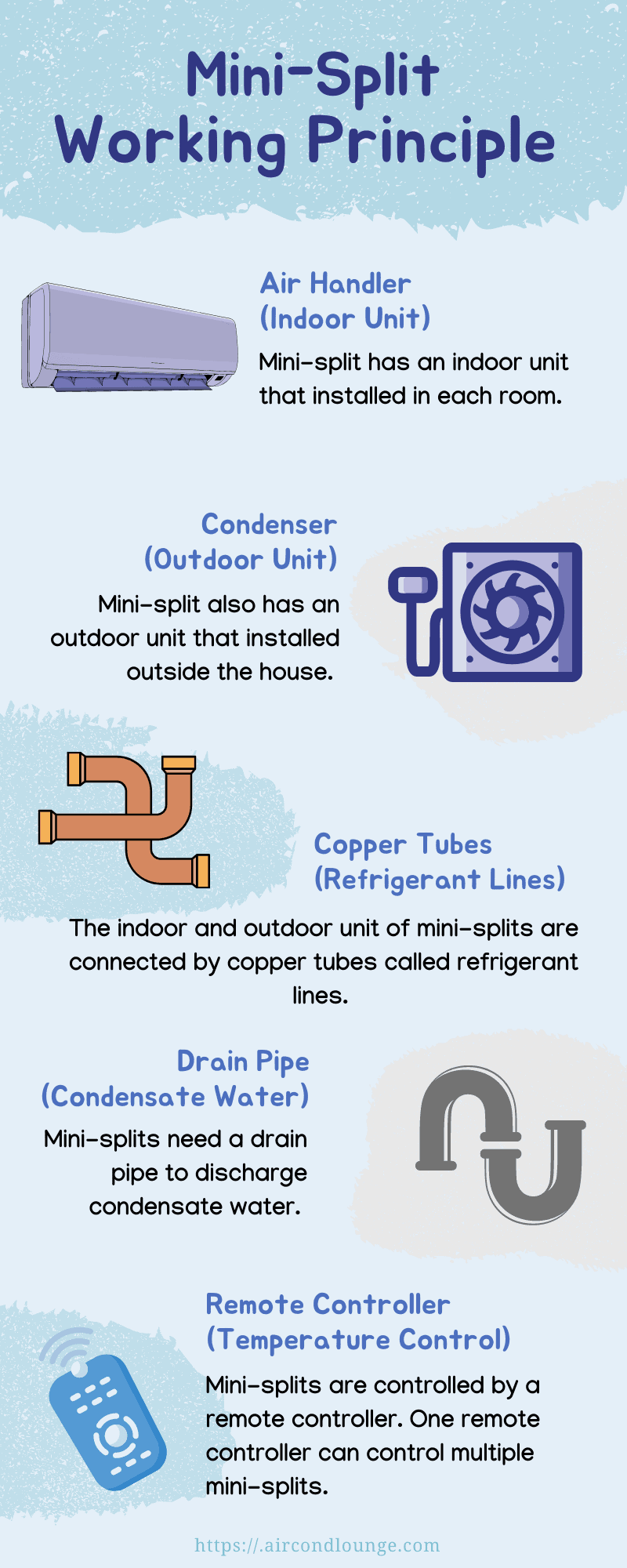
In between the indoor unit and the outdoor unit of a mini-split is a pair of insulated copper tubes. These copper tubes are known as the refrigerant line.
Inside the two refrigerant lines is a refrigerant. During operation, the refrigerant circulates through the indoor unit and outdoor unit for heat transfer.
Nowadays, most mini-splits are using the R410A refrigerant. In the near future, all mini-splits will progressively switch to the R32 refrigerant because it is more environmental-friendly.
The mini-split indoor unit that hangs on the wall must be connected to a small PVC drain pipe for condensate water discharge. Usually, the condensate drain pipe is connected to the nearest plumbing pipe.

In cooling, a mini-split also extracts moisture (dehumidification) from the air through condensation that happens within its indoor unit. That’s why we need to connect a drain pipe to the mini-split indoor unit.
The condenser (outdoor unit) of a mini-split works the same like the condenser of a central air conditioner. It has a compressor, a heat exchanger coil and a fan. However, the condenser of a mini-split is much smaller than the central air one.
While you use a wall-mounted display thermostat to control your central air conditioner, you are given a remote controller for every mini-split that you purchase. Hence, you use the remote controller to control the mini-split.
Fortunately, mini-split remote controllers are sharable. Meaning, you can use only one remote controller for all mini-splits in your house and they will still operate independently.
What’s the Disadvantages of Mini-Splits?
There are two common reasons for not choosing to use mini-splits:
- The first reason is that your house already has an existing ductwork for a central air conditioner.
- The second reason is that you don’t want to have a mini-split hanging on the wall.
From an engineering perspective, mini-splits are the best heating and cooling system for homes, considering cost and practicality.
Previously, houses are built with a centralized heating and cooling system because a gas furnace is the best system for heating.
Nowadays, mini-split heat pumps can deliver the same performance. Not to mention, they are much better for the environment.
However, if your house already has existing ductwork, switching from a central air conditioner to multiple mini-splits may cost you more initially. But, you can save monthly electricity costs later.
If you really don’t want to see mini-splits hanging around your house, you can explore different types of mini-splits other than the wall-mounted type to see if any of those match your needs.
How’s the Buying Process of a Mini-Split Like?
Usually, when you want to buy a central air conditioner or a gas furnace, you may choose the condenser, the fan blower and the heat exchanger coil separately. Most of the time, you’ll seek advice from a professional.
However, it is common for people to choose and buy mini-splits all by themselves because the selection process is much simpler and straightforward.
All of the components of a mini-split are designed and selected by the manufacturer. You don’t have to select them separately and also, you can’t customize them.
Instead, you choose your preferred mini-split models from a catalog provided by the manufacturer. Here is an example of a mini-split catalog: Daikin Mini-Split Catalog.
If you read any mini-split catalog, you’ll find that it is very long and complicated. No worry, the following will show you how’s the mini-split selection process:
Step 1: Single-Zone and Multi-Zone
Whether it is an air conditioner version or a heat pump version, you need to first decide between a single-zone mini-split or a multi-zone mini-split.
As the name suggests, single-zone mini-splits provide only one temperature zone control. Whereas for multi-zone mini-splits, you can have several temperature zone controls.
Basically, a single-zone mini-split has one outdoor unit that connects to only one indoor unit. Meanwhile, a multi-zone mini-split has one bigger outdoor unit that connects to 3-5 indoor units.
If your house has 4-6 rooms that need heating and cooling (eg: bedrooms, living room, dining room and kitchen), you can either install a single-zone mini-split in each room or use a multi-zone mini-split to serve all rooms.
With single-zone mini-splits, you’ll have 6 outdoor units outside your house and 6 indoor units inside your house (one indoor unit in each room). All mini-splits are controlled independently.
With multi-zone mini-splits, you’ll have 1 outdoor unit outside your house and 6 indoor units inside your house (one indoor unit in each room). All mini-splits are also controlled independently.
Unless you don’t have enough space outside your house or you think that having a lot of outdoor units outside your house is not good looking, I would suggest you go for single-zone mini-splits because they are more reliable, cheaper and more efficient.
You may see my post Multi Split or Single Split? Consider this ONE thing to solidify your decision.
Step 2: SEER and HSPF Ratings
SEER or seasonal energy efficiency ratio is an energy efficiency rating for cooling. Meanwhile, HSPF or heating seasonal performance factor is an energy efficiency rating for heating.
To make your mini-split selection process more efficient, you can start by looking at mini-splits with around SEER 24 and HSPF 12. This kind of efficiency rating is considered good. Nonetheless, the least efficient mini-splits are still better than most central air conditioners.
Needless to say, the higher the SEER and HSPF values, the more expensive it gets. So, the best way is the strive for a balance between efficiency and cost.
Step 3: Low Ambient Heating
Mini-splits often get a bad rep for being useless or performing poorly in cold climates. However, it is often not the problem with the mini-split itself but the selection process.
There is a version of mini-splits that are designed to perform well in extreme cold (below freezing). These mini-splits can be named differently such as hyper-heating, arctic and low ambient heating.
If you’re living in a very cold place, you must choose the low ambient heating model of mini-split heat pumps. However, take note that these models are usually much more expensive.
Step 4: Heating and Cooling Capacity
Like central air conditioners, mini-splits are available in several different capacities. The most common one is the 9000 BTU model followed by the 12000 BTU, 18000 BTU and 24000 BTU models.
In most cases, you only need one 9000 BTU mini-split in each bedroom. For the living room, a 12000 BTU or 18000 BTU mini-split is usually enough. The same goes for the kitchen and the dining room.
Nowadays, mini-splits have inverter technology. Meaning, they can regulate their capacity based on the needs. Mini-splits with inverter technology are sometimes known as variable speed mini-splits.
Normally, you should seek advice from a professional in order to choose the right mini-split capacity. However, you also can see my post Air Conditioner Sizing Guide: Sizing Chart (BTU & Ton) to make your own decision.
How’s the Installation Process of a Mini-Split Like?
It is much simpler to install a mini-split than a central air conditioner and a gas furnace. However, a standard HVAC toolset is still needed.
The installation process of a mini-split starts with the mini-split indoor unit. A technician will discuss it with you before mounting it on a suitable wall. The position of the mini-split indoor unit is important for the performance of the mini-split.
To learn more about mini-split positioning, see my post Best Place to Put the Mini Split Air Handler and Condenser.
Once the mini-split indoor unit is mounted on the wall, the technician will proceed to drill a 3″ hole beside the indoor unit for the refrigerant lines, drain line and electrical wiring.
Next, the technician will place the mini-split outdoor unit either on the floor or on a mounting bracket. Finally, the technician will perform tests and connect the refrigerant lines, drain line and electrical wiring to both the indoor unit and the outdoor unit of the mini-split.
How’s the Service Process of a Mini-Split Like?
The heat exchanger coil and the filter of a mini-split are the two items that need regular services. Fortunately, both items are very easy to be cleaned.
The cover of the mini-split indoor unit can be opened for service. Mini-split filters are removable. So, you can take them out and clean them with normal water.

As for the heat exchanger coil, it is similar to a central air conditioner. You can either use a coil cleaning form or call a professional to help.
Sometimes, a mini-split may leak water due to a clogged drain line. However, it can be fixed relatively easily.
When compared to a central air conditioner, mini-splits don’t have issues such as imbalanced heating/cooling and low airflow. These problems are often associated with ductwork.
How’s the Lifespan of a Mini-Split?
Long-term reliability is one of the considerations when deciding on a new HVAC system. While central air conditioners often last about 15-20 years, mini-splits last about 10-15 years.
However, the performance of central air conditioners deteriorates is harder to retain than the performance of mini-splits due to the complex ductwork.
A 10-year old central air conditioner may suffer low airflow, insufficient cooling and high electricity cost problems because of dirty ducts that are causing high air resistance. At the same time, duct cleaning work is costly and tedious and thus, people rarely do it unless there is a problem.
On the other hand, a 10-year old mini-split can perform close to a new one because dirt is not an issue since it can be easily and thoroughly cleaned.
In addition, mini-splits are more reliable than central air conditioners because you can still have heating and cooling if one or two mini-splits stop working. Whereas if a central air conditioner stop working, your entire house will have no heating and cooling.
When Should You Use a Mini-Split?
Quiet operation and high efficiency are indeed good. However, not everyone has the ideal condition to use a mini-split. So, when should you use a mini-split then?
Generally, you should consider using a mini-split when your house doesn’t have a built-in central air conditioning and heating system. Besides, you should also consider putting a mini-split in additional rooms that you just built or renovated.
Rooms such as the garage, the basement and the sunroom where a central air conditioner can’t reach are perfect for a mini-split.
1) Your existing ductwork is in poor condition
When your house is built with a central air conditioning and heating system, it is more cost-efficient to replace a new central air conditioner or gas furnace than to install multiple mini-splits.
However, if you have an old house and the ductwork is in poor condition, replacing it with mini-splits is not a bad idea because repairing all the ductwork can be very costly.
2) You just built an additional room
If you recently added a new room to your house, extending the ductwork from your existing central air conditioner can be very costly. Not to mention, your existing system may not have sufficient capacity to handle it.
So, you can consider putting a mini-split in the additional room as a separate heating and cooling system.
3) You don’t have an existing ductwork in your house
It is the best time to consider using a full mini-split system in your house if the house doesn’t already have existing ductwork. Installing new ductwork in a house is extremely costly.
Central air conditioners are not as efficient as mini-splits. So, this is the best time to consider a much more efficient heating and cooling system to reduce your monthly electricity cost.
4) Gas cost is getting higher
If you notice that the operating cost of a gas furnace is increasing or the gas cost in your area is generally higher, you can consider switching to mini-split heat pumps.
5) You want to save energy and reduce electricity cost
Mini-splits are more efficient than central air conditioners. So, if you’re thinking of saving more energy to help the environment while reducing your house’s electricity cost, you can definitely consider switching to mini-splits.
Some of the Best Mini Splits on the Market
Mini-splits are the most common type of air conditioning system in the world. Hence, there are many different brands and models of mini-split available on the market.
Here are my top pick for the best mini-splits:
- Daikin ATMOSPHERA: Most Efficient Mini-Split
- Mitsubishi MSZ-FS: Best Mini-Split for Cold Climate
- Panasonic ClimaPure XE: Mini Split that Provide the Best Air Quality
- MrCool DIY 3rd Generation: Easiest Mini-Split to Install by Yourself
- Gree Vireo+: Best 115V Mini-Split
- Senville LETO: Best Budgeted Mini-Split
- LG Art Cool Mirror: Mini-Split with Best Appearance
If you want to see my review on each of the above listed mini-split, check out my post 7 Best Mini Split Air Conditioners (2022 Buyer’s Guide).
List of Common Mini-Split Brands
- Daikin
- Panasonic
- Mitsubishi
- Fujitsu
- LG
- Gree
- Pioneer
- Senville
- MrCool
- Midea
More Resources on Mini-Splits
There are a lot more about mini-splits. If you want to learn more about them, check out my top posts about mini-splits as follow:
- Can You Run Mini Split Refrigerant Lines in Walls?
- Is a Mini Split Good for a Garage? (Heating & Cooling)
- Is Mini Split Good for Sunroom? (Sizing & Installation Guide)
- Do Mini Splits Work in Cold Weather Climate Effectively?
Alternatively, you can see over 25 posts on topics about mini-splits in my mini-split blog archive.
Lastly, consider my Mini Split (eBook) if you want to know how can you use Mini Split in your house. If you still have doubt or not feeling confident enough, feel free to consult me.
Consultation Service
Ask me for HVAC advice such as brand selection, best model, benefits, features, placement, duct size, grille size, how to design, design check, verification and other HVAC related queries.
If you have anything to add (or ask) about this topic, leave a comment down below!



